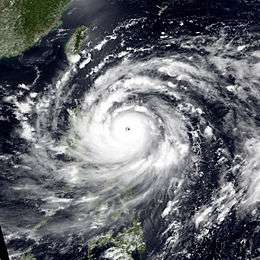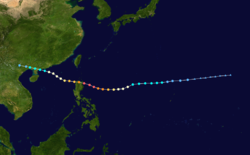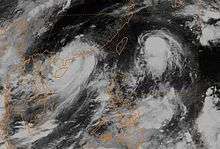Typhoon Gordon (1989)
Super Typhoon Gordon, known in the Philippines as Typhoon Goring, was a powerful tropical cyclone that caused widespread damage and loss of life in the Philippines and Southern China in July 1989. Originating from a single cumulonimbus cloud on July 9, Gordon developed into a tropical depression near the Northern Mariana Islands and quickly intensified as it tracked west-southwestward. On July 13, the storm attained typhoon status and subsequently underwent a period of rapid intensification. By July 15, the storm attained its peak strength as a Category 5 equivalent super typhoon with winds estimated at 260 km/h (160 mph). After striking the northern Philippines, Gordon moved through the South China Sea and slowly weakened. On July 18, the storm made landfall in southern China and was last noted the following day as it dissipated over land.
| Typhoon (JMA scale) | |
|---|---|
| Category 5 super typhoon (SSHWS) | |
 Typhoon Gordon approaching Luzon near peak intensity on July 15 | |
| Formed | July 9, 1989 |
| Dissipated | July 19, 1989 |
| Highest winds | 10-minute sustained: 185 km/h (115 mph) 1-minute sustained: 260 km/h (160 mph) |
| Lowest pressure | 915 hPa (mbar); 27.02 inHg |
| Fatalities | 306 total |
| Damage | $381 million (1989 USD) |
| Areas affected | Philippines, Hong Kong, Taiwan, Macao, and China |
| Part of the 1989 Pacific typhoon season | |
Throughout Gordon's path from the Philippines to China, the storm caused widespread damage and loss of life. Across the Philippines, 90 people were killed by the typhoon and an estimated 120,000 people were left homeless. Though a weaker storm when it struck China, damage was more severe due to extensive flooding. Several coastal cities were completely inundated. Throughout the country, at least 200 people died and losses reached 1.2 billion yuan ($319 million USD).[nb 1] Additionally, 14 people drowned offshore and 2 others died in Hong Kong.
Meteorological history

In early July, widespread showers and thunderstorms developed across the Western Pacific underneath a tropical upper tropospheric trough (TUTT). On July 9, a single cumulonimbus cloud west of Wake Island became associated with the TUTT and quickly organized. By July 11, the system featured a small central dense overcast and soon became sufficiently organized for the Joint Typhoon Warning Center (JTWC) to declare it as Tropical Depression 11W.[nb 2] Upon classification, the system was located roughly 320 km (200 mi) east of the Northern Mariana Islands. The development of the depression was unprecedented in two ways: first, a single cloud developed into a tropical cyclone; and second, it became tropical while situated underneath a cold-core low.[2]
Following the system's classification as a tropical cyclone, the depression maintained a west-southwesterly track in response to a subtropical ridge to the north. On July 12, it is estimated that the depression intensified into a tropical storm, at which time it was given the name Gordon by the JTWC.[2] Due to the cyclone's proximity to the Philippines, the Philippine Atmospheric, Geophysical and Astronomical Services Administration also monitored the storm and assigned it with the local name Goring.[3] During the afternoon of July 13, Gordon briefly turned southwestward as it attained typhoon status before returning to a more westerly track later that day.[2]
As the TUTT gradually warmed, Gordon was able to undergo a prolonged period of rapid intensification, despite having restricted outflow. Over a 30-hour period from July 14 to 15, the storm's central pressure decreased by 70 mbar (hPa; 2.07 inHg), just below the threshold for explosive intensification. At the end of this phase, Gordon attained its peak strength as a Category 5 equivalent super typhoon with winds estimated at 260 km/h (160 mph).[2] Around the same time, the Japan Meteorological Agency (JMA) assessed the storm to have attained 10-minute sustained winds of 185 km/h (115 mph) along with a minimum pressure of 915 mbar (hPa; 27.02 inHg).[4][nb 3]
Once classified a super typhoon, Gordon acquired a slight northerly component to its track and maintained a general west-northwestward trajectory for the remainder of its existence. Late on July 15, Gordon made landfall in northern Luzon, Philippines, at peak intensity. Remaining over land for several hours, the storm quickly weakened before entering the South China Sea. The system maintained minimal typhoon status as it developed a large, ragged eye by July 17. Slight weakening took place hours before Gordon made landfall as a strong tropical storm near Zhanjiang in Southern China on July 18. Briefly moving over the warm, shallow waters of the Gulf of Tonkin, Gordon's convective structure tripled in size; however, the system continued to weaken. Later that day, the storm made its final landfall in southern Guangxi Province. Once onshore, Gordon quickly weakened and was last noted on July 19 by the JMA over southern Guangxi.[2][4]
Preparations and impact
Philippines
Across Luzon, air traffic was temporarily suspended on July 16 until the typhoon's passage. Storm signal three, the highest level of warning, was issued for five provinces while lesser warnings were in place for most of the northern Philippines.[6] The Philippine Coast Guard ordered all vessels in Luzon to remain at port until the storm's passage. Residents along the coast were urged to take "extreme precaution."[7] All activities at the United States' Clark Air Base were canceled on July 16 while emergency rescue and cleanup teams were placed on standby. All non-essential personnel were ordered to remain home.[6]
Striking northern Luzon on July 16, Typhoon Gordon packed sustained winds estimated at 260 km/h (160 mph),[2] though the strongest reported winds reached 186 km/h (116 mph).[8] At Wallace Air Station, wind gusts reached 126 km/h (78 mph). Torrential rains accompanying the storm, measured up to 747 mm (29.8 in) at Clark Air Base, caused widespread flooding and landslides.[2][8] Across Cagayan Valley, flash flooding prompted thousands of residents to evacuate to higher ground. Travel in much of the region was severely impaired as landslides blocked off roads.[9] Baguio was mostly isolated from surrounding areas as the main roads leading in and out of the city were blocked off.[10] In Paoay, a bridge was washed out and high winds from the typhoon tore the roof off a public market.[11] According to the Philippine Red Cross, nearly 11,000 people were in evacuation shelters by the evening of July 16 in Ilocos Norte.[12] In La Union, three towns were submerged in flood waters up to rooftops of homes after a river burst its banks.[13]
Throughout the country, 90 fatalities resulted from the typhoon. Additionally, 386 people were injured while another 3 were listed as missing. A total of 8,845 homes were destroyed and another 46,269 sustained damage.[3] An estimated 120,000 people were left homeless due to Gordon.[2] Losses from the typhoon amounted to 1.36 billion pesos (US$62 million).[3][14] By July 18, relief operations began across northern Luzon.[15] Philippine President Corazon Aquino declared a state of calamity for five provinces and three towns by this time.[16]
Hong Kong, Taiwan, and Macao

On July 15, the Central Weather Bureau issued a sea warning for the Bashi Channel and waters off the southeast coast of Taiwan. Residents were also warned of possible heavy, flooding rains and were urged to take precautions to minimize loss of life.[17]
Regarded as the "fiercest typhoon to threaten Hong Kong in five years,"[18] the Hong Kong Observatory began issuing storm signals by July 16 to warn residents of the approaching storm. Early the next day, the signal was raised to three (strong wind signal) before being further increased to signal eight (gale warning) that afternoon.[19] All ferries to and from Macao were halted and all schools were closed. Warnings urging residents to take steps to avoid unnecessary losses were continuously broadcast over radio stations.[18] The normally busy Hong Kong was brought to a standstill as businesses, banks and courts closed for the storm.[20] This included the Hong Kong Stock Exchange and the Chinese Gold and Silver Exchange.[21][22] Public transport was mostly shut down and the government opened 78 shelters. Thousands of people were evacuated from low-lying areas along the coast. Approximately 11,000 Vietnamese "boat people" were also moved to emergency shelters.[20]
Winds up to 192 km/h (119 mph) battered parts of Hong Kong, downing numerous trees, snapping power poles and blowing out windows.[19] Driven by the intense winds, airborne debris injured 31, 6 of whom required hospitalization.[21] Two fatalities took place in the territory: one on Lantau Island and another in Tai O. Some flooding took place as a result of Gordon, especially along coastal areas where the typhoon brought a storm surge of 1.36 m (4.5 ft).[19]
In Macao, high winds from the typhoon uprooted trees and broke windows. Flooding triggered by Gordon's heavy rains stranded cars and inundated stores. Five of the colony's six casinoes were temporarily closed.[23] Flooding also caused the Macau-Taipa bridge to collapse.[19]
China
Striking Guangdong Province as a strong tropical storm, Gordon caused extensive damage in the region. Along the coast, approximately 155 km (96 mi) of dykes were destroyed by storm surge.[19] Already suffering from extensive floods, heavy rains and record tides from Typhoon Gordon caused "massive" flooding in Zhuhai, Guangdong. Flood waters over-topped dams and sea walls and inundated the city.[24] Approximately 11,000 people were forced to seek refuge on the roof of their homes.[16] One of the hardest hit cities was Yangjiang where flood waters caused widespread damage. Roughly 46,000 homes were damaged or destroyed in the city while 252 km (157 mi) of highway and 26 bridges were washed away.[19] Telecommunications in Guangzhou, the capital of Guangdong, was completely lost due to the storm and parts of the city were isolated due to flooding.[25] Across the province, an estimated 140,000 hectares (350,000 acres) of farmland was flooded.[19] High winds in Yangchun caused several structures to collapse.[16] Flooding also caused extensive damage to infrastructure with 22 bridges destroyed and 225 km (140 mi) of roads under water.[25] Offshore in the South China Sea, 24 fishermen were caught in the storm and became stranded. The crew drifted in the sea for 24 days, during which time 14 perished, before the survivors were rescued.[26] Heavy rains also fell in parts of Guangxi Province; however, the rains were mostly beneficial to farmers.[19] Throughout southern China, at least 200 people were killed by the typhoon and damage amounted to 1.2 billion yuan (US$319 million).[27]
See also
- 1989 Pacific typhoon season
- Other tropical cyclones named Gordon
- Typhoon Angela (1989)
- Typhoon Brian (1989)
- Typhoon Dot (1989)
- Typhoon Dan (1989)
- Typhoon Elsie (1989)
- Typhoon Mangkhut - A storm with a similar track.
Notes
- All monetary values are in 1989 USD, Philippine pesos, or Chinese Yuan
- The Joint Typhoon Warning Center is a joint United States Navy – United States Air Force task force that issues tropical cyclone warnings for the western Pacific Ocean and other regions.[1]
- The Japan Meteorological Agency is the official Regional Specialized Meteorological Center for the western Pacific Ocean.[5]
References
- "Joint Typhoon Warning Center Mission Statement". Joint Typhoon Warning Center. United States Navy. 2011. Archived from the original on July 26, 2007. Retrieved January 7, 2012.CS1 maint: unfit url (link)
- 1st Lt. Robert J. Falvey (1990). "1989 Annual Tropical Cyclone Report: Typhoon Gordon (08W)" (PDF). Joint Typhoon Warning Center. United States Navy. pp. 64–68. Retrieved March 27, 2012.
- "Destructive Typhoons 1970-2003". National Disaster Coordinating Council. November 9, 2004. Archived from the original on November 9, 2004. Retrieved March 27, 2012.
- Japan Meteorological Agency (October 10, 1992). "RSMC Best Track Data - 1980-1989". Archived from the original (TXT) on December 5, 2014. Retrieved March 27, 2012.
- "Annual Report on Activities of the RSMC Tokyo - Typhoon Center 2000" (PDF). Japan Meteorological Organization. February 2001. p. 3. Retrieved March 27, 2012.
- "Typhoon Gordon Weakens As It Hits Land". Manila, Philippines: Associated Press. July 16, 1989. (accessed through LexisNexis)
- "Typhoon Roars Toward Philippines, U.S. Bases on Alert". Manila, Philippines: Associated Press. July 15, 1989. (accessed through LexisNexis)
- "Typhoon kills 12". Manila, Philippines: The Pittsburgh Press. July 17, 1989. p. A3. Retrieved January 12, 2012.
- "Typhoon Hits Northern Philippines". Manila, Philippines: Xinhua General News. July 16, 1989. (accessed through LexisNexis)
- "Typhoon Gordon claims seven lives in the Philippines". Manila, Philippines: United Press International. July 16, 1989. (accessed through LexisNexis)
- "Typhoon Batters Philippines; At Least Five Dead". Manila, Philippines: Associated Press. July 16, 1989. (accessed through LexisNexis)
- "Typhoon kills 22 in Philippines". Manila, Philippines: United Press International. July 17, 1989. (accessed through LexisNexis)
- "Storm Leaves Thousands Homeless". Manila, Philippines: Associated Press. July 17, 1989. (accessed through LexisNexis)
- "International Disaster Database: Disaster List". Centre for Research on the Epidemiology of Disasters. 2012. Archived from the original on September 23, 2010. Retrieved January 13, 2012.
- "Relief Operations In Full Swing". The Philippine Star. Manila, Philippines: Xinhua General News. July 19, 1989. (accessed through LexisNexis)
- "Typhoon kills five in China, strands thousands". Beijing, China: United Press International. July 19, 1989. (accessed through LexisNexis)
- "Sea Warning Issued As Typhoon Gordon Moves Closer". Taipei, Taiwan: Central News Agency. July 15, 1989. (accessed through LexisNexis)
- "Typhoon Gordon Approaching South China Coast". Hong Kong: Xinhua General News. July 17, 1989. (accessed through LexisNexis)
- "Tropical Cyclones In 1989" (PDF). Hong Kong: Hong Kong Observatory. October 1990. pp. 32–37. Retrieved January 13, 2012.
- "Hong Kong Battens Down as Typhoon Gordon Approaches". Hong Kong: Associated Press. July 17, 1989. Missing or empty
|url=(help) (accessed through LexisNexis) - "Killer Typhoon Gordon moves into China". Beijing, China: United Press International. July 18, 1989. (accessed through LexisNexis)
- "Foreign Exchange Rates In Hong Kong". Hong Kong: Xinhua General News. July 18, 1989. (accessed through LexisNexis)
- "Typhoon lashes China". Reuters. Hong Kong: The Toronto Star. July 18, 1989. p. B6. (accessed through LexisNexis)
- "Toll from summer rains climbs to 1,400 in China". Reuters. Beijing, China: The Toronto Star. July 19, 1989. p. A19. Missing or empty
|url=(help) (accessed through LexisNexis) - "Typhoon Gordon leaves at least 17 dead in China". Beijing, China: United Press International. July 20, 1989. (accessed through LexisNexis)
- "14 Fishermen Perish". Hong Kong: Palm Peach Post. August 12, 1989. p. 6A. (accessed through LexisNexis)
- "typhoon lola to hit shanghai". Shanghai, China: Xinhua General News. August 3, 1989. (accessed through LexisNexis)
